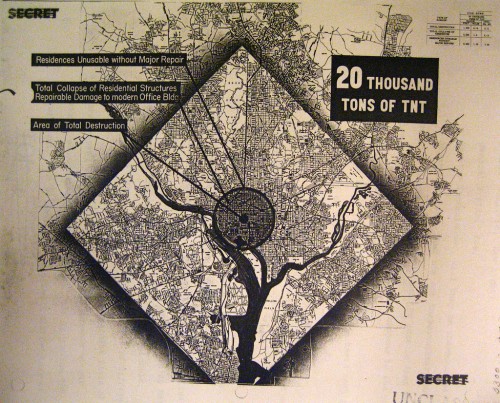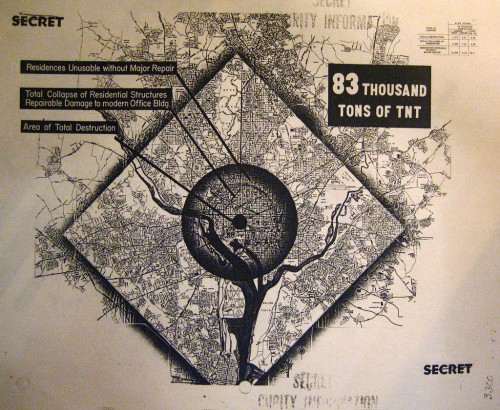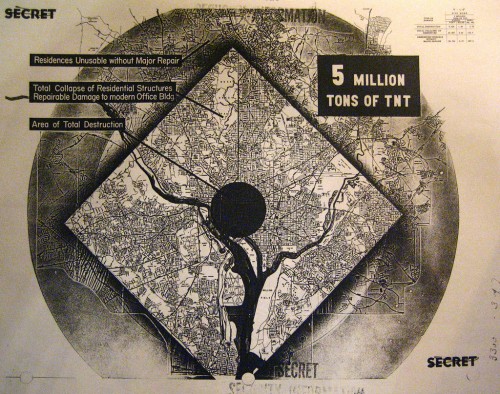Today’s image of the week comes from the files of the Joint Committee on Atomic Energy (JCAE). In February 1953, the JCAE got their first briefing from the Atomic Energy Commission about the success of Operation Ivy, where the first hydrogen bomb prototype was detonated just a few months earlier. This was given in a Top Secret Executive session, which was only declassified in 2009, and thus is only available at the Legislative Archives in downtown Washington, D.C., so I was excited to get my hands on it on my most recent research trip.
In order to explain to the gathered Congressmen the effects of the hydrogen bomb, Brig. Gen. Kenneth E. Fields, the AEC’s General Manager at the time, showed three charts to them, illustrating the yields of the Nagasaki bomb (20 kilotons), a current stockpile fission bomb (83 kilotons), and a hypothetical hydrogen bomb (5 megatons):
From the transcript:
Gen. Fields: Now, briefly, just to put perspective on the effects of the weapons that we have had and do have, the growth in the yield, the maximum yield obtainable. Here are three charts that show the effects of different weapons. The Hiroshima or Nagasaky [sic], approximate yield of this weapon. One of our very prominent members of our present stockpile of fission weapons, the 83,000-ton TNT equivalent. And we have just selected 5 million tons as a possibility in the thermonuclear field. 1 You can see the differences in the areas covered.
Rep. Cole: Is that a map of Washington?
Gen. Fields: Yes. The zero point is over the White House.
Rep. Van Zandt: Not the Capitol?
Gen. Fields: Not the Capitol.
Rep. Van Zandt: Well, all right. (Laughter.) 2
What’s the laughter about? As always from these kinds of transcripts, it can be hard to discern tone. What is the joke in determining whether the White House or the Capitol should be the transcript, for a bunch of people currently sitting in the Capitol? Is it an expression of gratitude (they are not, strictly, the target), or a question about the true seat of power (who really ought to be the target)? Fields himself probably just wanted them to understand the relative distances in terms any Washingtonian would understand — the length of the National Mall — but the result is, of course, that they are learning about their new weapon’s effects by seeing themselves through the bombsight.
A number of historians and commentators have discussed the fact that in studying how your weapons would effect an enemy, one quickly moves the cross-hairs to your own cities. That is, the United States almost immediately went from studying the effects of an atomic bomb centered over the city of Hiroshima (e.g.) to studying the effects over New York and Washington, DC. Peter Galison calls this the “bombsight mirror,” after Lacan’s notion of the mirror stage:
Here stands a new, bizarre, and yet pervasive species of Lacanian mirroring. Having gone through the bomb-planning and bomb-evaluating process so many times for enemy maps of Schweinfurt, Leuna, Berlin, Hamburg, Hiroshima, Tokyo, and Nagasaki, now the familiar maps of Gary, Pittsburgh, New York City, Chicago, and Wichita began to look like them. 3
This bombsight mirroring happened continuously throughout the nuclear age, when the enemy was assumed to be, in technological terms, symmetrical. We have nukes, they have nukes. We have ICBMs, they have ICBMs. It’s also the essence of game theory: we are both rational; we infer that they infer much like we do. This mirroring is a big part of the Cold War, and had interesting historical outcomes. It superficially looks like empathy, but it’s really likely just fear.
So I enjoy that there is some hesitation on the part of the Congressmen to have DC be the center of the scopes, as they sit in DC discussing these new weapons. I enjoy that they feel the need to make some nervous laughter about whether the Capitol (where they sit) or the White House (where Eisenhower sits) is the primary target. In that fleeting moment of laughter is a recognition, I think, of the terrifying world they played no small part in creating.
- 5 Mt is of course less than half of the Ivy Mike yield. But as the transcript makes clear, even by early 1953 they were not certain what the Mike yield actually was — they put it at 8Mt (+/- 2Mt) — because their standard radiological methods of assessing yield were complicated by the fact that so much of the yield was from fission of the uranium-238 tamper, which they lacked previous experience analyzing. It’s also the case that Mike was not a finalized stockpile weapon at all, and they were not yet sure that the lithium-fueled designs that would be tested in Operation Castle would work, or what yields they would have. So 5Mt is not a horrible guess for what a stockpile H-bomb might look like, despite being less than the Mike experiment.[↩]
- Source for images and quotes: Executive Session of the Joint Committee on Atomic Energy (18 February 1953), in Records of the Joint Committee on Atomic Energy, RG 128, National Archives and Records Administration, Washington, D.C., Declassified Executive Session Transcripts, Box 12.[↩]
- Peter Galison, “War Against the Center,” Grey Room, no. 4 (Summer 2001), 5-33, on 30.[↩]





[…] This kind of transfer worries me much more than the innovations created wholly by people on the “below” side of the field. A clever terrorist, working in isolation, can surely come up with some nasty scenarios. But nothing seems worse than when those from “below” get their hands on the death-dealing tools made by those from “above.” There’s a potential, I think, to lose sight of the fact that the weapons we make are likely to get turned on us eventually. […]
[…] historically contextualized than your average web […]
[…] Ivy Mike was, of course, the first test of a staged, multi-megaton thermonuclear weapon: the first hydrogen bomb. With an explosive yield of 10.4 million tons of TNT, it was a grim explication how tremendously destructive nuclear arms could be. Even Congressmen had difficulty making sense its power. […]
[…] tests of the 1950s, observing the explosions themselves did not impress me nearly as much as seeing a map of Washington with the bomb crater laid over it, the circles indicating the reach of total destruction enclosing the entire […]